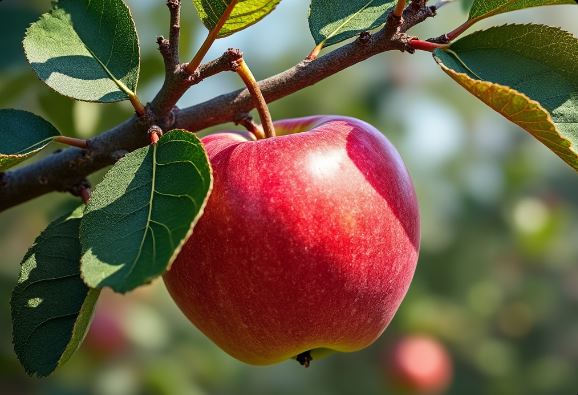
Fuji apples, botanically classified as Malus domestica, are a late-ripening variety that belongs to the Rosaceae family. The Fuji apple was developed in the late 1930s by breeders at the Tohoku Research Station in Fujisaki, Aomori, Japan. The name “Fuji” comes from Fujisaki, the town where the research station is located, not directly from Mount Fuji.
Under the Fuji apple name, there are also multiple varieties found in Japan that have been created from different cultivation methods and are known as the sun-fuji and moon fuji. Sun-fuji apples are allowed to receive direct sunlight when growing to increase the sugar content in the flesh, while moon fuji apples are bagged and protected from the sun until they are ready to be picked.
The apple was created by crossing two American apple varieties: the Red Delicious and the Virginia Ralls Janet (also known as Rawle’s Genet). This crossbreeding aimed to combine the sweet taste and good storage qualities of the parent varieties. The Fuji apple was introduced to the market in 1962 after several years of testing and cultivation.
After introduction, Fuji apples quickly became one of the most commonly grown apple varieties in Japan, and in 1980, it was introduced to the United States, where it also saw widespread commercial success. Today Fuji apples are one of the most popular sweet apple varieties in the world and are commercially grown in Japan, China, the United States, and Australia.
Over the years, various strains and mutations of Fuji apples have been developed to enhance color, size, or storage life. There are now several recognized strains like the Yataka Fuji, Redsport, and others, each with slightly different traits.
Fuji apples are moderately sized fruits and have a round to ovate shape with a lopsided appearance. The semi-thick skin is smooth, waxy, and has a yellow-green base, covered in red-pink striping and blush. The classic Fuji often has a red or pink blush over a yellow-green background, but the exact coloration can vary:
- Solid Red: Some strains, especially those grown in regions with cooler nights, can develop a nearly solid red color, resembling the Red Delicious in hue but usually with more yellow or green at the base or around the stem.
- Striped or Variegated: Many Fuji apples have a striped or variegated pattern where red or pink stripes run over the lighter background.
Inside, the flesh is white or cream-colored, with a slight yellow or green tinge near the skin. The flesh is dense, aqueous, crisp, fine-grained, encasing a central core filled with small, black-brown seeds. The core is relatively small compared to the size of the apple, with seeds arranged in a typical star pattern when the apple is cut in half horizontally. Fuji apples are crunchy and low in acid, creating a mild and balanced, sweet-tart flavor with notes of honey and citrus.
Cultivation of Fuji Apples
Climate and Location
- Temperature: Fuji apples thrive in climates with a good balance of warm days and cool nights, which helps in developing their characteristic sweetness and color. They require a significant number of chill hours (periods of cold weather) to break dormancy in spring, typically between 1,000 to 1,400 hours below 45°F (7°C).
- Sunlight: Full sun is essential for Fuji apple trees. They need at least six hours of direct sunlight daily for optimal growth and fruit production.
- Soil: Well-drained, loamy soil with a pH between 6.0 and 7.0 is ideal. Soil should be rich in organic matter but not overly fertile, as too much nitrogen can lead to excessive vegetative growth at the expense of fruit quality.
Planting
- Spacing: Trees should be planted with enough space to allow for growth and air circulation. Typically, standard trees are spaced about 15-20 feet apart, while dwarf varieties can be closer, around 8-12 feet.
- Rootstock: Fuji apples are often grafted onto rootstocks that can control the tree’s size (dwarf, semi-dwarf, or standard), influence disease resistance, and adapt to different soil conditions.
Care and Maintenance
- Watering: Consistent watering is crucial, especially in dry periods. However, overwatering can be detrimental. Young trees need more frequent watering than established ones.
- Pruning: Annual pruning in late winter or early spring is necessary to remove dead or diseased wood, encourage air circulation, and shape the tree for better light penetration. This also helps in managing the size of the tree and improving fruit quality.
- Fertilization: Balanced fertilization with less nitrogen helps in promoting fruiting over excessive leaf growth. Soil tests can guide the exact nutrient needs.
- Mulching: Mulch around the base helps retain soil moisture, regulate soil temperature, and reduce weed competition.
Pest and Disease Management
- Pests: Common pests include aphids, codling moths, and apple maggots. Integrated Pest Management (IPM) strategies, including natural predators, traps, and selective pesticides, are often employed.
- Diseases: Fuji apples can be susceptible to diseases like apple scab, powdery mildew, and fire blight. Disease-resistant rootstocks, proper spacing for air flow, and fungicides or bactericides can be used as preventive measures.
Harvesting
- Timing: Fuji apples are late-season apples. They are harvested from late September through October in the Northern Hemisphere. The exact time can vary based on local climate conditions.